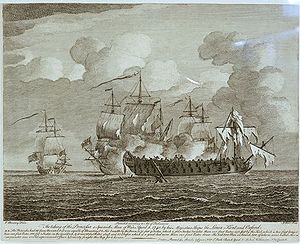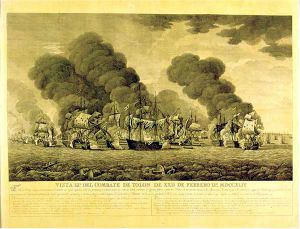HMS Princess (1740)
 The taking of the Princessa a Spanish Man of War, April 8, 1740, by his Majesties Ships the Lenox, Kent and Oxford, an engraving of a work by Peter Monamy | |
| Career (Spain) | Spanish Navy Ensign |
|---|---|
| Name: | Princesa |
| Builder: | Guarnizo, Santander |
| Launched: | 1730-31 |
| Captured: | 8 April 1740, by the Royal Navy |
| Career (Great Britain) | |
| Name: | HMS Princess |
| Acquired: | 8 April 1740 |
| Fate: | Sold for breaking up on 30 December 1784 |
| General characteristics | |
| Class and type: | 70-gun third rate ship of the line |
| Tons burthen: | 1,709 3/94 bm |
| Length: |
165 ft 1 in (50.3 m) (overall) 130 ft 3 in (39.7 m) (keel) |
| Beam: | 49 ft 8 in (15.1 m) |
| Depth of hold: | 22 ft 3 in (6.78 m) |
| Propulsion: | Sails |
| Sail plan: | Full rigged ship |
| Complement: | 480 |
| Armament: |
|
HMS Princess was a 70-gun third rate ship of the line of the Royal Navy. She had briefly sailed as the Princesa for the Spanish Navy, until her capture off Cape Finisterre in 1740 during the War of the Austrian Succession.
After being chased down and captured by three British ships, she was acquired for service by the Royal Navy. Her design and fighting qualities excited considerable interest, and sparked a series of increases in the dimensions of British warships. She went on to serve under a number of commanders in several theatres of the War of the Austrian Succession, including the Mediterranean, where she was at the Battle of Toulon, and in the Caribbean and off the North American coast. She was then laid up and being assessed, was not reactivated for service during the Seven Years' War. She was instead reduced to a hulk at Portsmouth, in which capacity she lasted out both the Seven Years' War and the American War of Independence, being sold for breaking up in 1784, shortly after the end of the latter conflict, after a career in British service lasting 44 years.
Spanish career and capture
Princesa was built between 1730 and 1731, being nominally rated at 70 guns, but carrying 64.[1] On 25 March 1740 news reached the Admiralty that two Spanish ships had sailed from Buenos Aires, and were bound for Spain. Word was sent to Portsmouth and a squadron of three ships, consisting of the 70-gun ships HMS Kent, HMS Lenox and HMS Orford, under the command of Captain Colvill Mayne of Lenox, were prepared to intercept them.[2] The ships, part of Sir John Balchen's fleet were briefly joined by HMS Rippon and HMS St Albans, and the squadron sailed from Portsmouth at 3am on 29 March, passing down the English Channel.[2] Rippon and St Albans fell astern on 5 April, and though Mayne shortened sail, they did not come up. On 8 April Mayne's squadron was patrolling some 300 miles south-west of The Lizard when a ship was sighted to the north.[2]
The British came up and found her to be the Princesa, carrying 64 guns and a crew of 650 under the command of Don Parlo Augustino de Gera.[3][4] They began to chase her at 10am, upon which she lowered the French colours she had been flying and hoisted Spanish ones. Mayne addressed his men saying 'When you received the pay of your country, you engaged yourselves to stand all dangers in her cause. Now is the trial; fight like men for you have no hope but in your courage.'[4] After a two and half hour chase the British were able to come alongside and exchange broadsides, which eventually left the Spanish ship disabled.[2] The British then raked her until she struck her colours.[2] The Spanish ship had casualties of 33 killed and around 100 wounded, while eight men were killed aboard both Kent and Orford, and another one aboard Lenox.[3] Total British wounded amounted to 40, and included Captain Durell of Kent, who had one of his hands shot away.[3] The commander of Orford during the engagement had been Lord Augustus FitzRoy.[5]
British service
Princesa was brought into Portsmouth on 8 May 1740. An Admiralty order of 21 April 1741 authorised her purchase, and this was duly done on 14 July 1741 for the sum of £5,418.11.6¾d.[1][6] After a great repair she was fitted at Portsmouth between July 1741 and March 1742, for a total sum of £36,007.2.10d.[1] Her spirited resistance to three ships of equal rating attracted much comment. A contemporary description noted that she was larger than any British first rate and carried unusually large guns, many of them brass.[3] She was described as the finest ship in the Spanish Navy, with her high build allowing her to open her lower gunports in conditions that meant that her opponents could not.[7] The Admiralty finally had the ammunition to rouse Parliament from its complacency and fund a series of increases in British warship dimensions.[1]

Princess was commissioned under her first commander, Captain Perry Mayne, in July 1741. He was succeeded in 1743 by Captain Robert Pett, who took her out to the Mediterranean in December that year.[1] She was part of Admiral Thomas Mathews' fleet at the Battle of Toulon on 14 February 1744.[1] She came under the temporary command of Commander John Donkley in July 1745, though he was soon replaced by Captain Joseph Lingen, all the while continuing in the Mediterranean. Thomas Philpot took command in 1746, and Princess sailed for the Leeward Islands with Admiral George Townshend.[1] Captain John Cokburne took over in July 1746 and Princess first sailed to Louisbourg and then home after a gale.[1] She became the flagship of Admiral Richard Lestock later in 1746 and was present at the operations off Lorient from 20 to 25 September 1746.[1] In May 1747 Captain Lord Augustus Hervey took over command, and sailed to the Mediterranean, where in October 1747 she became briefly became the flagship of Vice-Admiral John Byng.[1]
Later years
Princess was paid off in November 1748. She was surveyed the following year but no repairs were reported.[1] After a period laid up and inactive she was reported to be unfit for service on 15 November 1755, she was converted to a hulk at Portsmouth between August 1759 and July 1761.[1][6] She was recommissioned in 1759 under Captain Edward Barber, and continued as a hulk during the Seven Years' War and the American War of Independence. Princess was finally sold at Portsmouth on 30 December 1784.[1][6]
Notes
- ↑ 1.00 1.01 1.02 1.03 1.04 1.05 1.06 1.07 1.08 1.09 1.10 1.11 1.12 Winfield. British Warships of the Age of Sail. p. 48.
- ↑ 3.0 3.1 3.2 3.3 Beatson. Naval and Military Memoirs of Great Britain. p. 75.
- ↑ 4.0 4.1 Matcham. A Forgotten John Russell Being Letters to a Man of Business. p. 126.
- ↑ Winfield. British Warships of the Age of Sail. p. 41.
- ↑ 6.0 6.1 6.2 Colledge. Ships of the Royal Navy. p. 277.
- ↑ Beatson. Naval and Military Memoirs of Great Britain. p. 76.
References
- Beatson, Robert (1804). Naval and military memoirs of Great Britain, from 1727 to 1783. 1. Longman, Hurst, Rees and Orme.
- Colledge, J. J.; Warlow, Ben (2006) [1969]. Ships of the Royal Navy: the complete record of all fighting ships of the Royal Navy (Rev. ed.). London: Chatham. ISBN 9781861762818. OCLC 67375475.
- The Navy In the War of 1739-48. Cambridge University Press.
- Matcham, Mary Eyre (2009). A Forgotten John Russell Being Letters to a Man of Business 1724-1751. BiblioBazaar, LLC. ISBN 111372434X.
- Winfield, Rif (2007). British Warships of the Age of Sail 1714–1792: Design, Construction, Careers and Fates. Seaforth. ISBN 1-86176-295-X.
